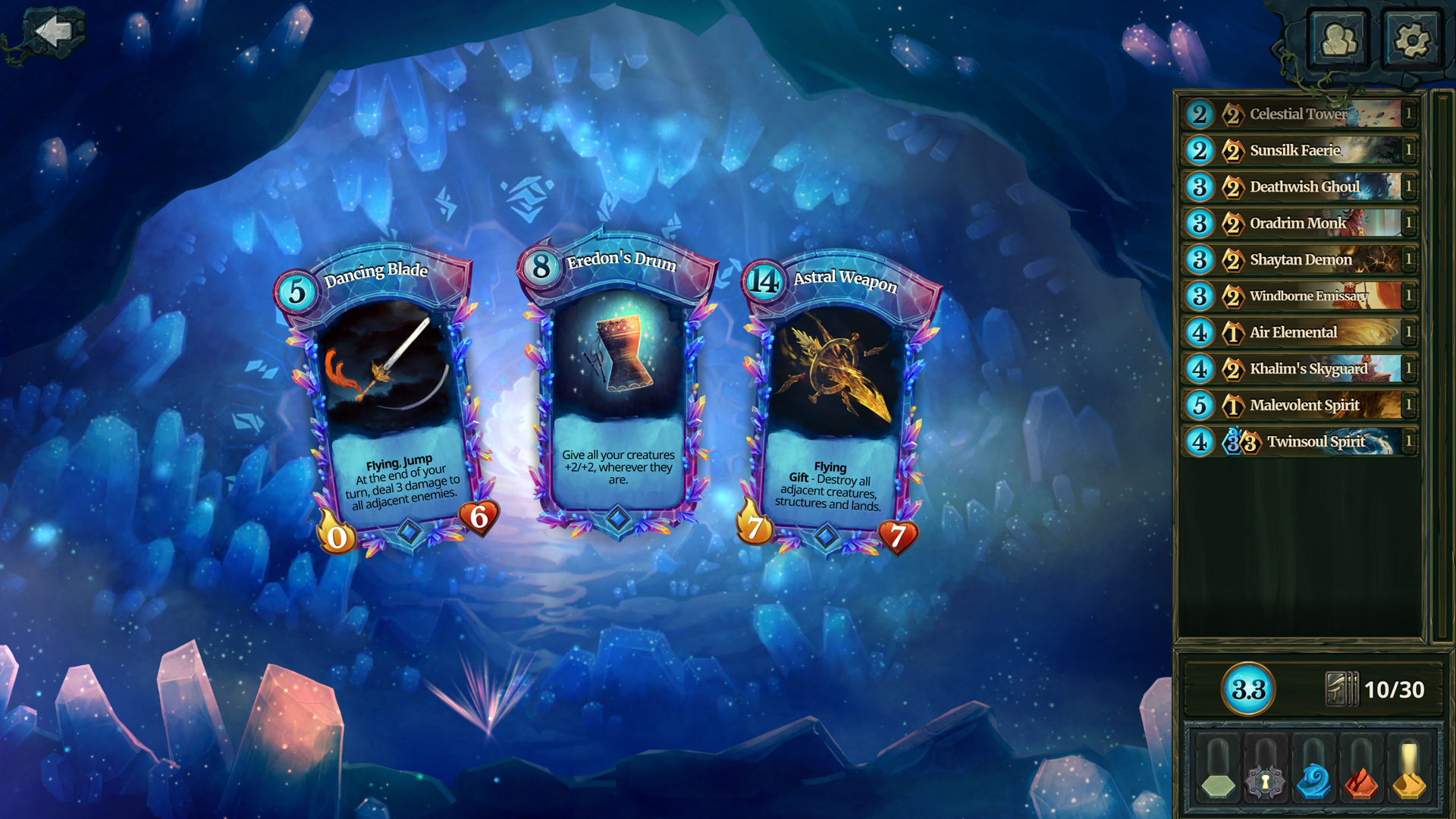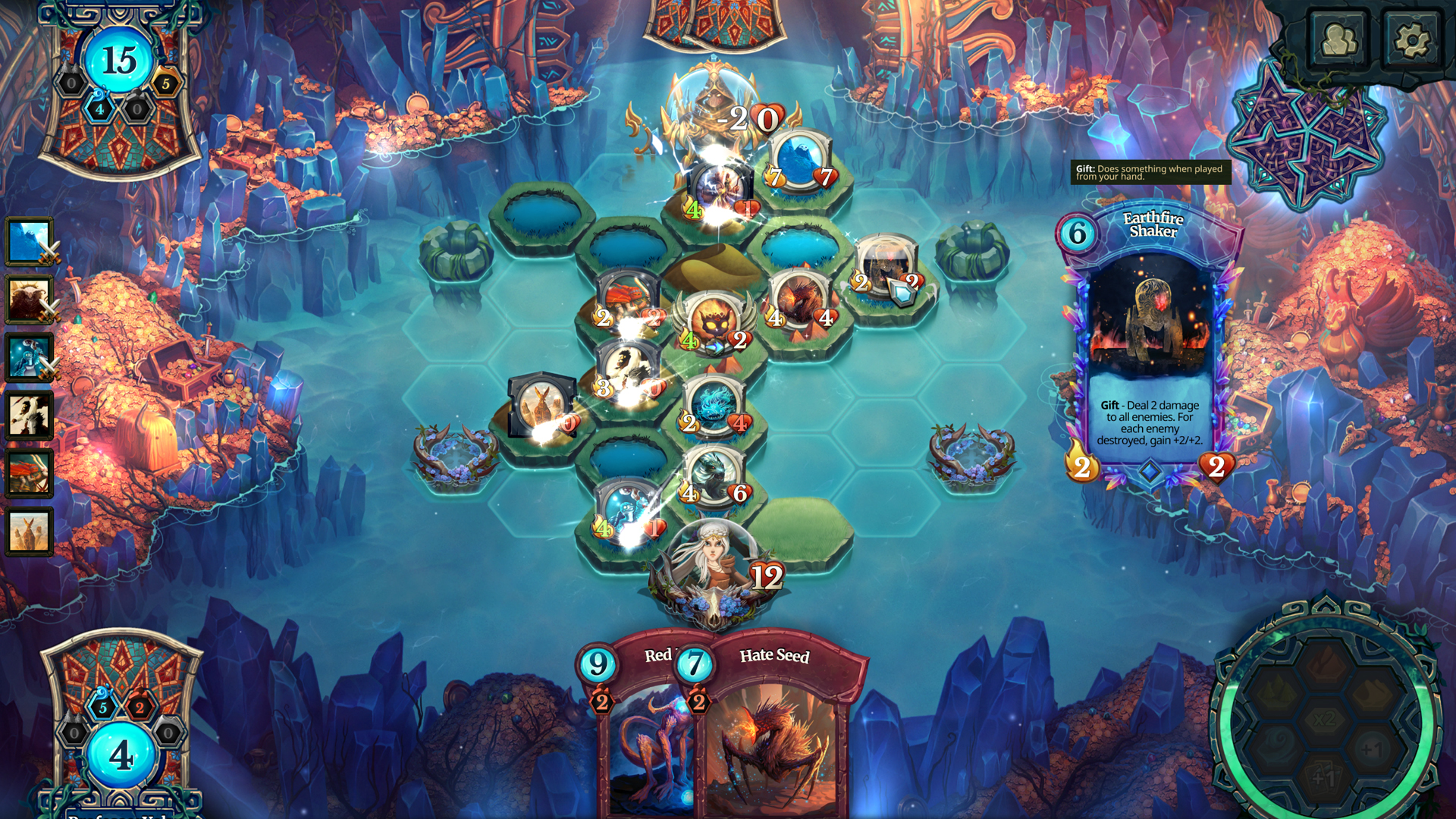12 years in development: interview with Faeria authors
In early March, the release of KKI Faeria from the Belgian studio Abrakam took place. The game has been in development for 12 years. We talked about the project with Corin Cole, the studio’s business development director.
Faeria is a card collectible game for two people. The metagame of the project is very similar to that of Magic The Gathering and Hearthstone. The player makes a deck of cards from boosters, selects cards that work best with each other within the framework of the strategy chosen for the arena.
The task in the core gameplay also coincides with the one found in the aforementioned popular projects. There are two players with a certain level of health in the battle arena. The task is to bring the opponent’s health to zero with the help of your own deck.
The key difference of Faeria is the battle arena. This is not an abstract table, within which an attacking card can immediately cause damage to another card or a mage, but a large field of hexes.
Initially it is covered with water. To get to the opponent, you need to build a road to him from the lands, which are given a limited number for each turn. The opponent is also building a path to you.
You can cast creature cards only on your own lands. Creatures can move, including on the lands exposed by the enemy. Caste strong cards often require a certain number of lands.
The situation is complicated by the large number of mana sources in the arena. A game party often turns into a war for resources.

Alexander Semenov, App2Top Editor-in-Chief: Let’s start from afar, with the history of the team. How did it happen that you got together and started doing CCI?
Corin Cole, Director of Business Development at Abrakam: Conversations about Faeria began back in 2005. Two of our five founders started actively discussing the game right then. But the company itself, Abrakam, was born only in 2013.
Initially, we wanted – I pay attention, this was before digital CCI became popular – to create a game as complex and interesting as Magic The Gathering, but which would be suitable for playing on digital platforms, would suit the widest possible audience.
It turns out that the game has been in development for almost 12 years. That’s a lot. What is the problem, why is it taking so long, and not a year, two, three?
Initially, Faeria was a side project. Because of this, the game developed slowly. It was only after the success on Kickstarter in October 2013 that we realized that Faeria had potential, felt that it could become much bigger and more popular than we initially hoped.
After that, we abandoned the web-based Flash client in favor of Unity. It was important to us that the game could become cross-platform in the future. And then, in 2013, and now, players often want to see their favorite project on mobile.
But as soon as the game became ready for testing by the community (and this happened in 2016), we immediately released it as part of early access on Steam.

The game spent a year in it. We wanted to make the project as cool as possible from our side.
Important: We continue to make Faeria bigger and better. For example, we recently announced a new content update with cooperative gameplay.
Your Kickstarter video shows that the project has undergone significant changes over the past three years. I am sure that the project has changed mechanics more than once in the development stage. Could you tell us what the fundamental stages of the game were. What major and important features and why were they rejected as part of the development?
The biggest change, as I said, was the transition from Flash to Unity. If we talk about the game… After Kickstarter, we realized that we had to significantly change the gameplay. So that, on the one hand, in accordance with our original desire, the game was interesting to a wide audience, but at the same time remained deep in strategic terms for more hardcore users.
We also abandoned the original plan to make Faeria a paid game in favor of a free-to-play model so that more players could enjoy the game.
You have successfully completed the Kickstarter. We have collected the necessary amount. But has he changed something in you?
He inspired us, our expectations from the project became higher. It affected everything from development to design. Plus, it helped raise more money – from investors – to achieve new ambitious goals.

The old video shows that, for example, you had such a feature as the time of day, and the positions of the players themselves were located diagonally to each other. Now the game has become pretty similar to Hearthstone in terms of the interface and some features. Why did they move closer to the Blizzard project, thereby losing originality?
We have worked hard to make the game more accessible. They cleaned a lot. Including the mentioned division by time of day. It gave the game an optional complexity, but did not add value.
UI/UX improvements were made until the very end. For example, the last two updates in the framework of early access have completely changed the UI of the game.
As for Hearthstone. There is a huge budget behind Hearthstone graphics. And if visual UI improvements like ours make the game “look like a Blizzard project,” then we take it as a compliment. At the same time, we did not look at Hearthstone as a landmark.
There are many CCIs that do just that – a slightly modified version of Hearthstone, but we don’t see the point in that. If someone wants to play Hearthstone, they should play Hearthstone, not something like it.
How, by the way, did the release of the Blizzard game affect you. What did you feel when you saw a game that also took MtG as a source of inspiration and managed to make KKI a really massive hobby?
We were delighted with Hearthstone’s success. When we started working on Faeria, we thought we would have to prove that digital CCIs have an audience. Seeing how well Blizzard is doing with Hearthstone, we realized that there is definitely an audience.

The gameplay of the game is based on the alignment of the field, the war for resources and the positional war. The game can be safely called because of this and the use of hexes by wargame. All these moments lengthen seriously the average session of the game. Today, there is a trend that the average session time is shortened in PvP. Is the game late for the market?
A difficult question. We know that short sessions help attract more casual players, but at the same time limits how strategic the game can be. As part of early access, we tested many things and observed how they affect data and user reviews. We think we have found a great balance. Over the past year, our average session has become shorter, but we haven’t lost in depth.
One of the selling points of the title is the graphics. Please tell me how you came to this style. and what was the primary story or picture?
We wanted to create a spirit world that would be inspired by animistic beliefs from all over the world.
The main task was to give a new look to the old fantasy concepts, to bring a fresh graphic direction that will appeal to a wide range of players: both young and old, and KKI enthusiasts, and those who have not played such games before, and boys, and girls, and parents … everyone.
In general, looking back, what would you have done differently when developing a game, what steps would you have refused from the point of view of management, business and game design?
Wow. I could talk about it for hours.

The creation of Faeria was a lesson for us in almost all areas. I don’t think there is a single person in our team who can’t write a long list of what he or she would do differently if he could start all over again. But this is the nature of creation: you need to experiment, make mistakes and improve.
Approaching the final question: you are based in Belgium. I understand that it is probably difficult for you to compare work here with development in other countries. But what features, pros and cons would you note in working in your country. What is easy and what is difficult from the point of view of business and development for you?
Belgium is a fantastic country. The government actively helps startups like ours.
The biggest drawback here is the frames. There are very few people here. Plus, inviting someone to move to a small Belgian city is not so easy.
Last question. According to the video that you posted on Kickstarter, it is clear that you work in such a cozy rustic environment, you even have chickens walking around the office. Such a home environment is not a minus in terms of concentration?
At the time when the video was shot for Kickstarter, our office was very small and homely, in which only our co-founders worked.
Things are a little different now.
We received the money during the investment round in early 2015. This led us to the startup incubator The Faktory. They have allocated us a large area, but we still feel like a family, working together.
There are no chickens here, but despite the fact that the office is located in a technopark, we often see cats and boars walking outside here.
